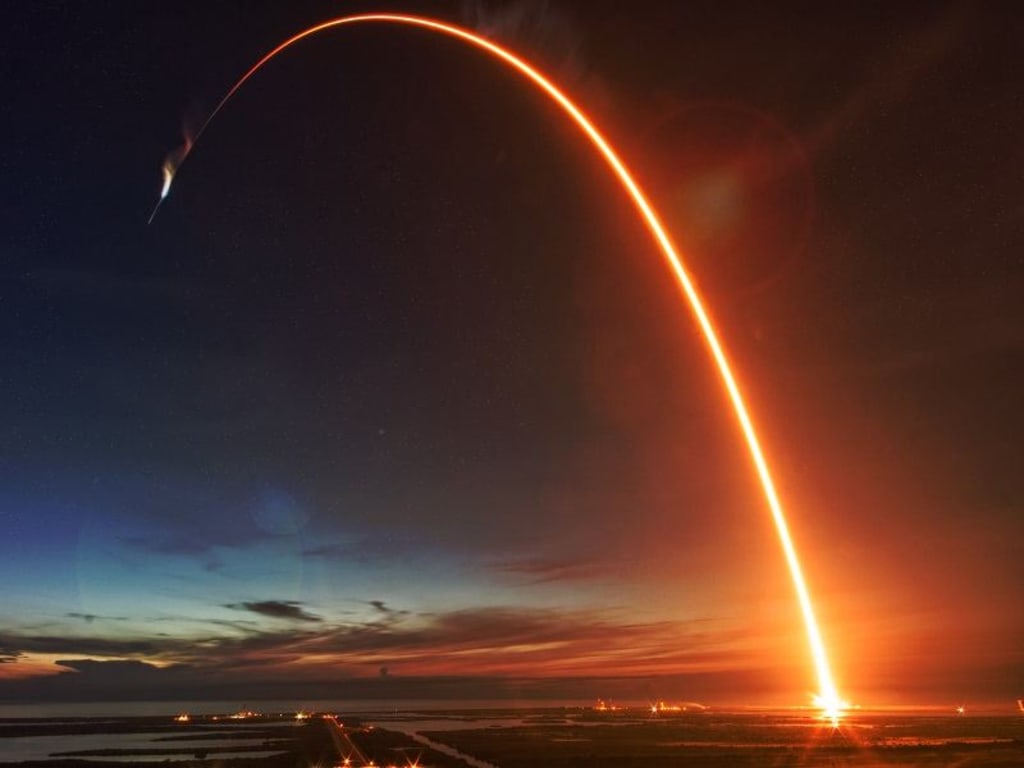"Fusion Rockets: Propelling Humanity Beyond the Stars"
"Unleashing the Power of Controlled Nuclear Fusion for Interstellar Exploration"

A fusion rocket is an advanced propulsion concept that harnesses nuclear fusion reactions to achieve extremely high thrust and specific impulse, making it a potentially revolutionary technology for space exploration. Unlike conventional chemical rockets that burn propellant to produce thrust, fusion rockets rely on fusing light atomic nuclei to release a tremendous amount of energy.
One of the primary challenges in developing a fusion rocket is to create and sustain the conditions necessary for nuclear fusion to occur. The most promising approach is to use magnetic confinement systems, such as the tokamak, to confine and heat the fusion fuel to the required temperatures and pressures. In this process, hydrogen isotopes like deuterium and tritium are used as the fuel source due to their abundance and ease of fusion.
Once the fusion reaction is initiated, the released energy heats up the rocket's exhaust, which is expelled at extremely high velocities through a magnetic nozzle. This results in an incredibly efficient and powerful thrust, enabling the rocket to achieve high speeds and reach distant destinations within our solar system in relatively short time frames.
The concept of a fusion rocket is not a new idea and has been explored in science fiction and scientific research for decades. However, substantial technical challenges remain, particularly in developing a practical and scalable fusion power system that can sustain the fusion reaction for long periods and fit within the confines of a space vehicle.
Researchers and scientists worldwide are actively investigating fusion energy for both terrestrial and space applications, with ongoing experiments and innovative engineering solutions to make the concept a reality. The successful development of a fusion rocket could revolutionize space travel, allowing us to explore the cosmos in ways that were once thought impossible.
A fusion rocket is a potentially game-changing propulsion technology for space exploration that harnesses nuclear fusion reactions for high thrust and specific impulse. While challenges persist, ongoing research and innovation offer hope for a future where fusion rockets propel humanity deeper into the cosmos.
1. Advantages of Fusion Rockets:
- High Specific Impulse: Fusion rockets have the potential to achieve specific impulses (a measure of efficiency) that are orders of magnitude higher than chemical rockets. This means they can reach much higher velocities, making interplanetary and interstellar travel more feasible.
- Abundant Fuel: The primary fuel for fusion rockets, deuterium, can be extracted from seawater, making it a virtually limitless and easily accessible resource.
- Reduced Travel Time: The high speeds achievable with fusion rockets could significantly reduce travel times to distant destinations, enabling faster exploration of our solar system and beyond.
- Sustainable Power: Fusion is a clean and sustainable energy source, producing minimal waste and no greenhouse gas emissions, which is essential for long-duration space missions.
2. Challenges and Technical Hurdles:
- Energy Requirements: Creating and sustaining the conditions for nuclear fusion requires a substantial input of energy, often exceeding the energy produced by the fusion reaction itself. Advancements in fusion technology and breakthroughs in energy confinement are needed to address this challenge.
- Magnetic Confinement: The magnetic confinement systems used to contain and control the superheated plasma must be highly efficient and stable to maintain the fusion reaction over extended periods.
- Miniaturization: Fusion power plants have traditionally been large and complex, but for space applications, miniaturization is crucial. Developing compact fusion reactors suitable for spacecraft is an ongoing area of research.
- Radiation Shielding: Fusion reactions release intense radiation, which poses challenges in designing effective shielding to protect both the crew and sensitive equipment on board.
3. Research and Initiatives:
- International Collaboration: Fusion research is a global endeavor, with numerous countries and organizations actively contributing to the development of fusion technology.
- Experimental Reactors: Various experimental fusion reactors, such as ITER (International Thermonuclear Experimental Reactor), are being constructed to advance our understanding of fusion and demonstrate the feasibility of controlled nuclear fusion.
- Innovative Concepts: Beyond traditional tokamak designs, alternative fusion concepts, like laser-driven inertial confinement fusion and magnetic confinement fusion using advanced stellarator configurations, are also being explored.
4. Space Exploration Potential:
- Interplanetary Travel: Fusion rockets could revolutionize crewed missions to Mars and beyond, significantly shortening travel times and reducing the physical toll on astronauts during long journeys.
- Interstellar Exploration: The potential of fusion rockets extends to interstellar travel, enabling missions to distant star systems within a human lifetime.
5. Inertial Confinement Fusion (ICF):
In addition to magnetic confinement, another approach to achieving controlled nuclear fusion is through inertial confinement fusion. In ICF, powerful laser beams or particle beams are directed onto a tiny fuel pellet, compressing and heating it rapidly to induce fusion reactions. While this method has been primarily investigated for laboratory-scale fusion experiments, it also has potential applications in propulsion systems for fusion rockets.
6. Propulsion Concepts:
Fusion rockets can be designed using various propulsion concepts, each with its own advantages and challenges:
- Fusion Pulse Propulsion: This concept involves detonating small fusion micro-explosions behind a spacecraft, creating a series of fusion-driven shockwaves that propel the spacecraft forward. It offers high thrust and efficiency but requires precise fusion ignition timing and fuel pellet injection.
- Continuous Fusion Propulsion: In this approach, the fusion reaction is sustained steadily to produce a continuous thrust. It necessitates stable and efficient containment of the fusion plasma for extended periods, making it a complex engineering challenge.
7. Interstellar Mission Challenges:
While fusion rockets offer the potential for interstellar travel, such missions are still highly ambitious and face several hurdles:
- Vast Distances: Even with fusion propulsion, interstellar voyages would require decades or centuries to reach nearby stars due to the immense distances involved.
- Life Support and Crew Considerations: For crewed missions, sustaining life support systems over such long durations poses significant challenges in terms of food, water, radiation protection, and psychological well-being.
- Relativistic Effects: As spacecraft approach relativistic speeds (close to the speed of light), time dilation effects become significant, leading to unique challenges in navigation, communication, and mission planning.
8. Synergy with Other Technologies:
Fusion rockets could synergize with other advanced space technologies, such as solar sails, to enhance mission capabilities. Combining propulsion methods might enable more efficient acceleration and deceleration during interstellar missions.
9. Spinoff Technologies:
Research and development in fusion propulsion have the potential to yield spinoff technologies with practical applications on Earth. Advanced materials, energy generation, and high-power propulsion systems could benefit industries beyond space exploration.
10. Ethical and Policy Considerations:
As with any revolutionary technology, the development and deployment of fusion rockets raise ethical and policy questions. International cooperation, environmental impacts, and potential weaponization concerns need careful consideration as fusion technology advances.
Fusion rockets hold immense promise for the future of space exploration. While significant challenges persist, ongoing research and international collaboration are driving progress in the development of fusion technology. If successfully harnessed, fusion rockets could open up new frontiers in space exploration and pave the way for humanity's expansion into the cosmos.
In conclusion, fusion rockets represent a cutting-edge frontier in space exploration, offering the potential for efficient and powerful propulsion to unlock the secrets of our universe. While significant challenges remain, the ongoing research and collaboration in fusion science hold the promise of a future where humanity ventures further into space, reaching distant planets and possibly exploring other star systems. As technology progresses, fusion rockets may become a pivotal tool in humanity's quest to understand the cosmos and ensure the sustainability of our presence beyond Earth.
About the Creator
Go With Trend
"Express, Connect, Impact - Welcome to "Go With Trend"!
Discover the magic of Letters on our vibrant platform. 🎙️ Share stories, sing your heart out, and connect with a global audience. 🌍 Unleash your creativity today! ✨ #"Go With Trend"






Comments
There are no comments for this story
Be the first to respond and start the conversation.